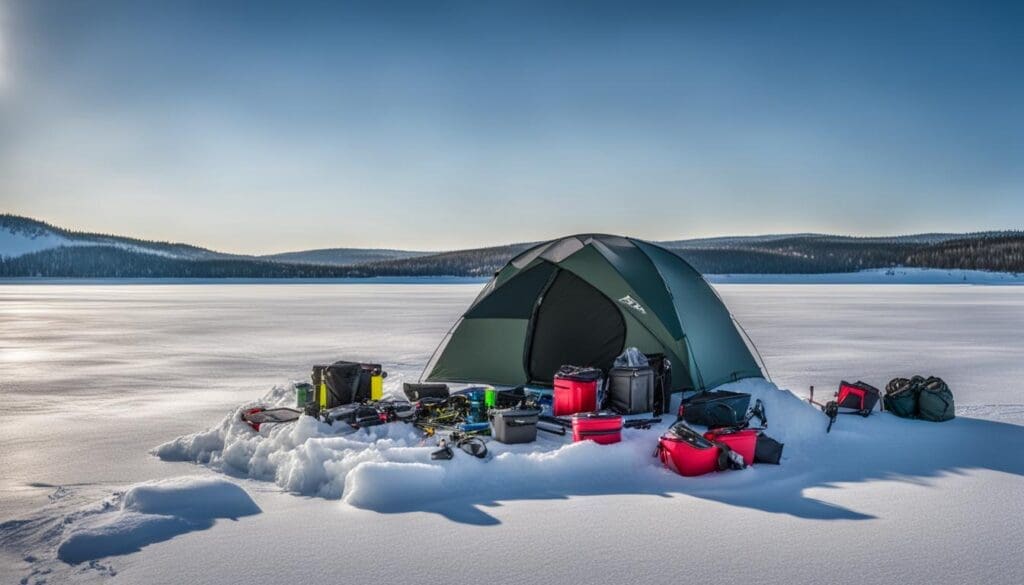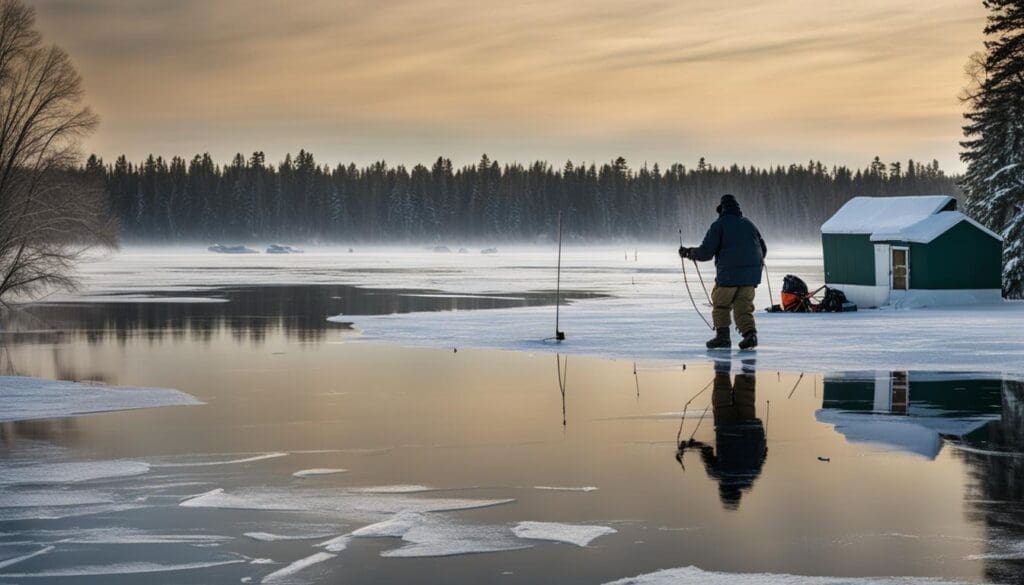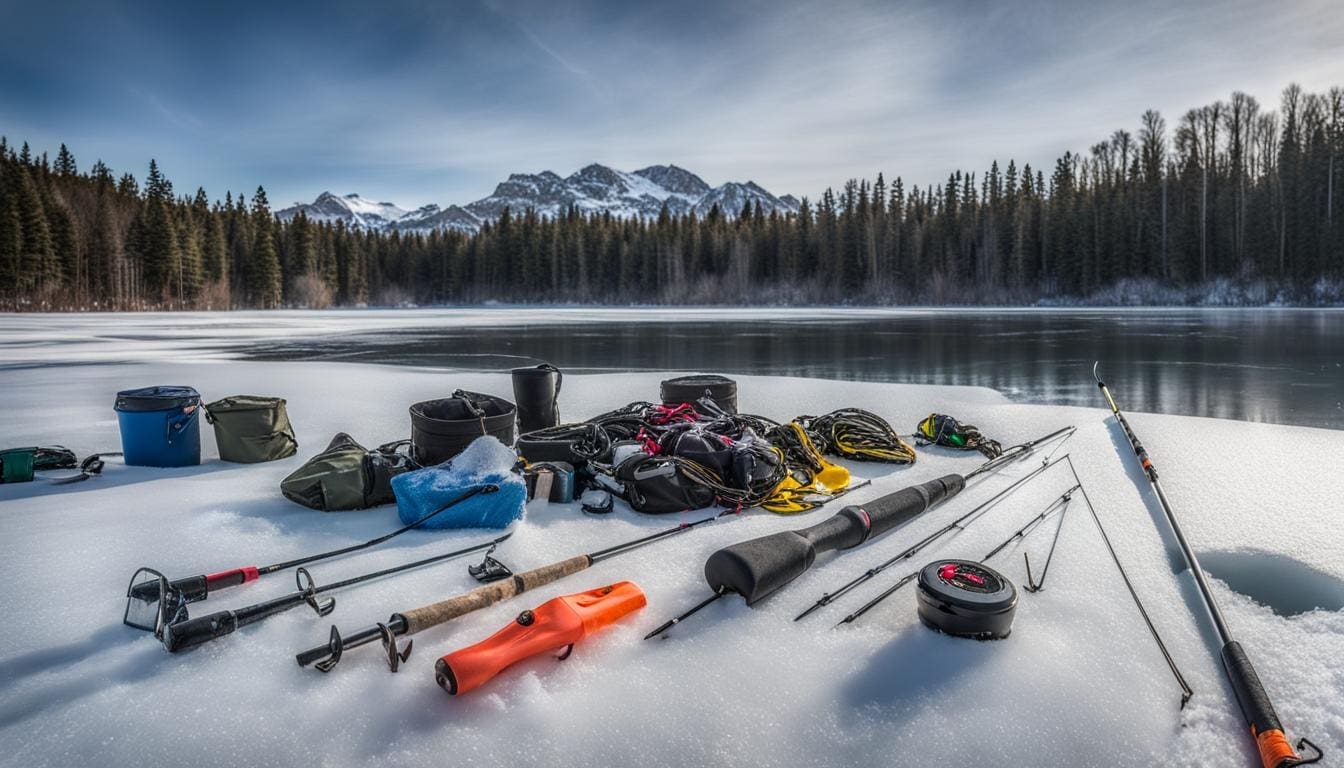Ice fishing is a popular winter activity that offers a unique and tranquil experience on frozen waters. However, it’s crucial to prioritize safety to ensure a safe and enjoyable ice fishing adventure. In this article, we will discuss the essential safety precautions and gear that every ice angler should be aware of. From understanding ice thickness to selecting the right equipment and following safety guidelines, we’ve got you covered.
Key Takeaways:
- Ice fishing requires prioritizing safety precautions to ensure a secure experience on frozen waters.
- Understanding ice thickness and following safety guidelines are crucial before venturing out onto the ice.
- Selecting the right ice fishing gear, including safety essentials, is essential for a successful outing.
- Proper techniques, such as drilling ice fishing holes and staying alert to changing conditions, contribute to a safe ice fishing experience.
- By following safety precautions, using the right gear, and staying aware, ice fishing can be a thrilling and enjoyable winter activity.
Understanding Ice Thickness and Safety Guidelines
Before venturing out onto the ice, it’s crucial to understand ice thickness and follow safety guidelines. The general rule is to avoid going on ice that is less than 4 inches thick. For safe ice fishing, it’s recommended to have at least 5 inches of clear solid ice. However, always double-check the ice thickness by asking locals or checking with the local wildlife and game departments. It’s also important to avoid areas with moving water, as the ice can be weaker. Stay safe by following these guidelines and assessing the ice conditions before going ice fishing.
When it comes to ice thickness safety, it’s important to remember that different factors can affect ice strength. These include the temperature, snow cover, and presence of pressure cracks. As the temperature fluctuates, the ice expands and contracts, causing cracks and weakening the ice. Additionally, snow can act as an insulator, preventing the ice from freezing uniformly and making it weaker. Pressure cracks are formed when the ice is squeezed together due to shifts in the water beneath it, creating areas of thinner ice. It’s essential to be aware of these factors and exercise caution when determining the safety of the ice.
Along with understanding ice thickness, it’s crucial to follow safety guidelines for ice fishing. These guidelines include fishing with a partner to ensure that someone can assist in case of an emergency and avoiding alcohol consumption, which can impair judgment and increase the risk of accidents. It’s also recommended to have a safety kit on hand, including items such as ice picks, a throw rope, and a personal floatation device. These tools can aid in self-rescue or rescue of others in the event of a fall through the ice. By being knowledgeable about ice thickness and adhering to safety guidelines, you can have a safe and enjoyable ice fishing experience.
| Ice Thickness | Safety Guidelines |
|---|---|
| Less than 4 inches | Avoid going on the ice |
| 5 inches of clear solid ice | Recommended for safe ice fishing |
| Double-check ice thickness | Ask locals or check with local wildlife and game departments |
| Avoid areas with moving water | Ice can be weaker |
Essential Ice Fishing Safety Gear
When it comes to ice fishing, having the right safety gear is crucial to ensure a safe and enjoyable experience. Here are some essential items to include in your ice fishing safety gear checklist:
1. Ice Fishing Suit or Jacket
An ice fishing suit or jacket is designed to keep you warm and protected from the cold temperatures and harsh weather conditions. Look for a suit or jacket that is waterproof, windproof, and insulated to provide maximum comfort and protection while on the ice.
2. Ice Cleats
Ice cleats are important for maintaining traction and preventing slips and falls on icy surfaces. Choose cleats that are easy to attach and fit securely over your boots. Opt for cleats with durable spikes or metal studs for better grip.
3. Ice Fishing Boots
Invest in a pair of sturdy and insulated ice fishing boots to keep your feet warm and dry. Look for boots with thick soles and good insulation ratings to protect your feet from the cold and wet conditions on the ice.
4. Ice Picks
Ice picks are essential for self-rescue in case you fall through the ice. These handheld tools have sharp spikes that you can use to grip onto the ice and pull yourself out of the water. Make sure to always wear them around your neck or securely attach them to your clothing for easy access.
| Essential Ice Fishing Safety Gear Checklist | |
|---|---|
| Ice Fishing Suit or Jacket | ✔️ |
| Ice Cleats | ✔️ |
| Ice Fishing Boots | ✔️ |
| Ice Picks | ✔️ |
5. Ice Fishing Shelter
An ice fishing shelter provides not only shelter from the elements but also serves as an extra safety precaution. It can protect you from strong winds, extreme cold, and falling snow or ice. Choose a portable and sturdy shelter that is easy to set up and take down.
6. Ice Chisel or Auger
An ice chisel or auger is essential for drilling holes in the ice to fish through. Make sure to choose a chisel or auger that is sharp and durable to easily cut through the ice. It’s important to keep the ice hole clear throughout your fishing trip to prevent accidents.
By equipping yourself with the right ice fishing safety gear, you can minimize risks and ensure a safe and enjoyable ice fishing experience. Prioritize safety and never venture onto the ice without the necessary gear and precautions. Stay warm, have fun, and make lasting memories while ice fishing!
Ice Fishing Rods and Reels
When it comes to ice fishing, having the right rods and reels can make a significant difference in your overall experience. While it’s not necessary to invest in specific ice fishing gear, there are a few considerations to keep in mind when choosing your equipment.
Firstly, using monofilament line is recommended for ice fishing. This type of line is durable and doesn’t stretch, which makes it easier to set the hook in cold weather conditions. Its low visibility in the water also increases the chances of attracting fish.
As for the rod, a shorter ice fishing rod in the range of three feet is ideal. The shorter length allows you to stay closer to the hole and maneuver more easily in extreme cold conditions. Additionally, look for a rod with a sensitive tip that can detect even the slightest nibble.
Comparison of Ice Fishing Rods and Reels
| Features | Ice Fishing Rods | Ice Fishing Reels |
|---|---|---|
| Length | Shorter (around 3 feet) | N/A |
| Material | Graphite or fiberglass | N/A |
| Tip Sensitivity | High | N/A |
| Line Compatibility | Monofilament | N/A |
Remember, the key to successful ice fishing is to be patient and observant. Take the time to understand the behavior of the fish in your chosen location and adapt your techniques accordingly. By using the right rods and reels, you’ll be well-prepared to reel in your catch and enjoy a rewarding ice fishing experience.
Selecting the Right Lures and Bait for Ice Fishing
Choosing the right lures and bait is essential for a successful ice fishing trip. When it comes to ice fishing lures, it’s important to consider the type of fish you’re targeting and the conditions of the water. For larger fish such as walleye or pike, live bait is often the most effective option. Using live bait can increase your chances of attracting and catching these species. Make sure to check the local regulations regarding the use of live bait before your trip.
During the winter months, fish have slower metabolisms and eat less. Therefore, downsizing your lures and bait is crucial. Smaller jigs and spoons are more likely to entice fish to bite. It’s also beneficial to experiment with different colors to see which ones the fish are more responsive to. Keep in mind that fish have different preferences, so it’s essential to have a variety of lures and bait options in your tackle box.
When presenting your bait in cold water conditions, it’s important to create a gentle and slow presentation. Fish are less active during winter, so a subtle approach is more likely to attract their attention. Dangle live bait around 15 feet below the surface to target fish at different depths. Patience is key when ice fishing, as it may take some time to find the right combination of lures, bait, and presentation techniques that work best for the fish in your area.
| Lure Type | Target Fish | Tips |
|---|---|---|
| Jigs | Panfish (bluegill, crappie) | Experiment with different colors and sizes. Try using live bait or adding bait to the jig. |
| Spoons | Walleye, pike | Downsize the spoons and experiment with different colors. Use a slow and subtle presentation. |
| Tip-ups | Pike, musky | Use live bait such as suckers or shiners. Set up multiple tip-ups in different locations. |
| Rattle Baits | Perch, walleye | Use various rattle bait colors and sizes. Experiment with different jigging motions. |
Additional Gear for Ice Fishing
While safety gear and fishing equipment are essential for ice fishing, there are a few additional items that can enhance your overall experience. These items can provide convenience, comfort, and efficiency during your time on the ice. Here are some additional gear options to consider:
Ice Fishing Augers
An ice fishing auger is a must-have tool for drilling holes in the ice. There are different types of augers available, including manual and gas-powered options. Manual augers are lightweight and portable, making them ideal for anglers who prefer to travel light. Gas-powered augers, on the other hand, offer more power and are suitable for drilling through thicker ice. Choose an auger that suits your needs and preferences.
Thermal Gear for Ice Fishing
Ice fishing can be a chilly activity, especially in colder climates. Investing in thermal gear is essential for staying warm and comfortable on the ice. Thermal clothing, such as insulated jackets, pants, and boots, can help retain body heat and protect against the cold. Additionally, thermal gloves and hats are important for keeping your extremities warm. Remember to layer your clothing to ensure maximum insulation.
Ice Fishing Sleds
An ice fishing sled is a practical accessory for transporting your gear across the ice. These sleds are designed to glide over the snow and ice, making it easier to transport your equipment to and from your fishing spot. Look for a sled with sturdy construction and sufficient space to hold your gear. Some sleds even come with built-in compartments or storage options, providing convenient organization for your tackle and accessories.
By including these additional gear items in your ice fishing arsenal, you can enhance your comfort, convenience, and overall enjoyment while out on the ice. Remember to prioritize safety and always check the ice conditions before heading out. Stay warm and have a successful ice fishing trip!

How to Safely Drill an Ice Fishing Hole
Drilling an ice fishing hole requires proper technique and safety precautions. Here are the basic steps for drilling an ice fishing hole:
Gather Your Equipment
Before starting, make sure you have the necessary equipment. You will need an ice auger, which can be manual or powered, depending on your preference. It’s also important to have a skimmer or ice scoop to remove the ice chips and clear the hole.
Choose the Right Location
Selecting the right location is crucial for successful ice fishing. Look for areas with a reputation for productive fishing, such as drop-offs or weed beds. Avoid areas with cracks, dark spots, or slush, as these can indicate thin or weak ice. Once you’ve chosen a spot, use a tape measure or ice chisel to determine the approximate thickness of the ice.
Drill the Hole
Position yourself firmly on the ice and hold the auger securely. Start drilling by applying downward pressure and turning the handle or starting the powered auger. Maintain a steady pace and keep the auger perpendicular to the ice’s surface. As you drill, periodically remove the ice chips using the skimmer or ice scoop. Continue drilling until you’ve reached the desired depth, usually around 8 to 10 inches.
Remember to always exercise caution and pay attention to the thickness and condition of the ice. If you encounter any signs of weak ice, such as cracking or creaking sounds, stop drilling immediately and find a safer location. By following these steps, you can safely drill an ice fishing hole and enjoy a successful day on the ice.
Staying Safe on the Ice
Ice fishing can be a thrilling and enjoyable winter activity, but it’s important to prioritize safety to prevent accidents and ensure a successful outing. By following these ice fishing safety precautions and tips, you can minimize risks and have a safe and memorable experience on the frozen waters.
Ice Fishing Safety Precautions
1. Check the ice thickness: Before stepping onto the ice, always check the thickness to ensure it’s safe for fishing. Remember, the minimum recommended thickness for safe ice fishing is 5 inches of clear solid ice. You can inquire with locals or consult the local wildlife and game departments for up-to-date information on ice conditions.
2. Stay away from moving water: Areas with moving water, such as inlets, outlets, and currents, are prone to weaker ice. Avoid these areas as the ice may be unstable and unsafe. Choose a location with still, solid ice for a secure fishing experience.
3. Bring essential safety gear: Equip yourself with the necessary safety gear, including a life jacket, ice picks, ice cleats, and a rope. These items can be crucial in case of an emergency or if you or someone else falls through the ice.
Ice Fishing Safety Tips
- 4. Fish with a buddy: It’s always safer to go ice fishing with a companion. Having someone with you can provide assistance in case of an accident or emergency.
- 5. Inform others about your plans: Before heading out, let someone know your itinerary and estimated return time. This way, if you encounter any issues, help can be alerted promptly.
- 6. Stay alert and observant: Pay attention to any changes in ice conditions or weather patterns. Be cautious of cracks, pressure ridges, or areas with discoloration, as they may indicate weaker ice.
- 7. Dress appropriately: Wear layered clothing to stay warm in freezing temperatures. Opt for moisture-wicking fabrics to keep dry and insulated, and don’t forget to wear a hat, gloves, and waterproof boots.
- 8. Practice hole safety: When drilling an ice fishing hole, be mindful of your surroundings. Keep a safe distance from other holes and avoid stepping on the ice near the edges of the hole.
Remember, ice fishing can be a great outdoor activity as long as you prioritize safety. By following these precautions and tips, you can minimize risks, prevent accidents, and have a fun-filled ice fishing adventure.
Tips for a Successful and Enjoyable Ice Fishing Trip
Ice fishing can be a thrilling and rewarding winter activity, providing the opportunity to catch fish in a serene frozen setting. To ensure a successful and enjoyable ice fishing trip, consider the following tips:
1. Choose the right location
Research and select a suitable ice fishing location that is known for its abundance of fish species. Check with local fishing guides, bait shops, or online forums for recommendations. Popular ice fishing destinations often have well-maintained access points and may offer amenities such as heated shelters or rental equipment.
2. Dress appropriately
Ice fishing trips can involve long hours in freezing temperatures, so it’s essential to dress appropriately to stay warm and comfortable. Layer your clothing to trap heat and insulate your body. Wear thermal base layers, a fleece or insulated jacket, and waterproof outerwear to stay dry. Don’t forget hats, gloves, and warm socks. Additionally, invest in insulated and waterproof boots to keep your feet warm and protected from the cold ice.
3. Use the right fishing techniques
Ice fishing requires different techniques compared to traditional open-water fishing. Take the time to learn and practice ice fishing techniques such as jigging, tip-up fishing, or dead-stick fishing. Experiment with different lure presentations, depths, and jigging motions to attract fish. Remember that fish are more sluggish during winter, so patience and finesse are key to success.

4. Stay organized and prepared
Prioritize staying organized and prepared for your ice fishing trip. Create a checklist of essential gear, including ice augers, fishing rods, tackle boxes, bait, and safety equipment. Pack extra layers, snacks, drinking water, and a thermos with hot beverages to keep energized and hydrated throughout the day. Don’t forget to bring a first aid kit, ice picks, and a rope for safety.
By following these tips, you can increase your chances of having a successful and enjoyable ice fishing trip. Remember to always prioritize safety, respect the ice conditions, and adhere to local regulations and guidelines. Enjoy the tranquility of frozen waters and the thrill of catching fish amidst the winter wonderland.
Conclusion
Ice fishing is a thrilling and enjoyable winter activity that allows you to experience the tranquility of frozen waters. However, safety should always be a top priority. By following the essential safety precautions and being prepared with the right gear, you can ensure a safe and successful ice fishing experience.
Always remember to check the ice thickness before venturing onto frozen waters. Follow the recommended guidelines and avoid areas with moving water. It’s also important to carry essential safety gear, such as ice picks, a life jacket, and a sled with a rope. These items can potentially save your life in case of an emergency.
Additionally, it’s always a good idea to fish with a buddy. Not only does it make the experience more enjoyable, but it also adds an extra layer of safety. If anything goes wrong, having someone there to help can make all the difference. Stay warm, stay safe, and make lasting memories while ice fishing!
FAQ
How thick should the ice be for safe ice fishing?
The general rule is to avoid going on ice that is less than 4 inches thick. For safe ice fishing, it’s recommended to have at least 5 inches of clear solid ice.
How can I determine if the ice is thick enough?
It’s important to double-check the ice thickness by asking locals or checking with the local wildlife and game departments. They will have the most up-to-date information on ice conditions.
Are there areas to avoid when ice fishing?
Yes, it’s important to avoid areas with moving water, as the ice can be weaker. Stay away from rivers, streams, and any areas where water is flowing.
Do I need special ice fishing rods and reels?
There is no need to invest in specific ice fishing gear. However, it’s recommended to use monofilament line, which is durable and doesn’t stretch, making it easier to set the hook in cold weather.
What size ice fishing rod should I use?
A shorter ice fishing rod in the range of three feet is ideal for staying closer to the hole and maneuvering in extreme cold conditions.
What kind of bait should I use for ice fishing?
Consider using live bait for targeting larger fish like walleye or pike. Downsizing your lures and bait is important during winter months, as fish have slower metabolisms and eat less.
Are there any additional items I should bring for ice fishing?
Some additional gear to consider includes ice fishing augers for drilling holes, thermal gear for keeping warm, and ice fishing sleds for hauling equipment.
How do I safely drill an ice fishing hole?
First, ensure the ice is thick enough. Use an ice auger to drill a hole, keeping the drill perpendicular to the ice. Once the hole is drilled, clear away any excess ice shavings.
What are some safety tips for ice fishing?
Always check the ice thickness before venturing out. Fish with friends or let someone know your plans. Carry essential safety gear, stay updated on weather conditions, and be cautious of cracks or pressure ridges in the ice.
Any tips for a successful ice fishing trip?
Be patient and observant. Move around if you’re not getting bites. Keep an eye on your tip-ups or ice fishing rods. Stay warm with appropriate clothing, bring snacks and drinks, and enjoy the peacefulness of the frozen waters.

